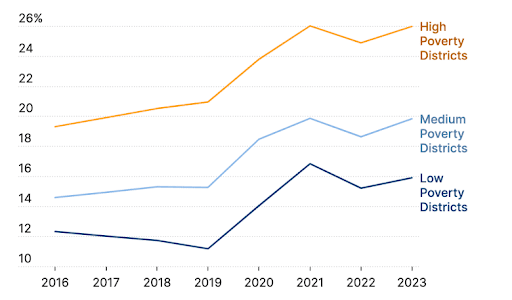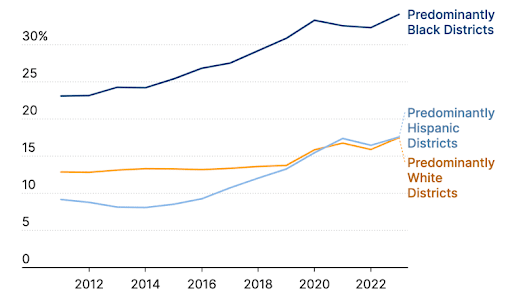Source: Brookings, “Declining public institution registration,” August 2025
Private school registration level
Prior to the pandemic, the share of trainees in standard public institutions held constant, hovering near 85 percent between 2016 and 2020 After the pandemic, standard public institution registration plummeted to below 80 percent and hasn’t rebounded.
The strange absent kids represent a big portion of the decrease. But family members also switched to charter and digital institutions. Charter institution registration climbed from 5 percent of pupils in 2016 – 17 to 6 percent in 2023 – 24 The number of kids attending virtual colleges nearly increased from 0. 7 percent before the pandemic in 2019 – 20 to 1 2 percent in 2020 – 21 and has actually stayed elevated.
Surprisingly, private school registration has stayed stable at nearly 9 percent of school-age youngsters between 2016 – 17 and 2023 – 24, according to this Brookings estimate.
I had actually expected private school registration to escalate, as family members soured on public school disturbances throughout the pandemic, and as 11 states, including Arizona and Florida, released their own educational savings account or new voucher programs to assist pay the tuition. But an additional analysis , released this month by researchers at Tulane University, echoed the Brookings numbers. It found that private school registrations had actually increased by only 3 to 4 percent between 2021 and 2024, contrasted to states without coupons. A new federal tax obligation debt to money private school scholarships is still more than a year away from going into impact on Jan. 1, 2027, and perhaps a better shift into personal education is still in advance.
Defections from conventional public colleges are biggest in Black and high-poverty districts
I would certainly have presumed that wealthier households who can afford independent school tuition would be most likely to look for alternatives. But high-poverty districts had the largest share of pupils outside the traditional public-school field. Along with private school, they were enrolled in charters, digital colleges, specialized institutions for trainees with handicaps or various other alternate institutions, or were homeschooling.
More than 1 in 4 students in high-poverty districts aren’t signed up in a traditional public institution, compared to 1 in 6 students in low-poverty institution areas. The steepest public school registration losses are focused in mainly Black institution areas. A 3rd of trainees in primarily Black districts are not in standard public schools, double the share of white and Hispanic pupils.
Share of student registration outside of traditional public colleges, by area poverty

Source: Brookings, “Declining public school registration,” August 2025
Share of students not enlisted in conventional public schools by race and ethnic background

Resource: Brookings, “Decreasing public college registration,” August 2025
These discrepancies issue for the students that stay in standard public schools. Institutions in low-income and Black areas are currently losing one of the most students, requiring even steeper budget cuts.
The demographic timebomb
Before the pandemic, united state colleges were already headed for a big tightening. The ordinary American female is currently giving birth to just 1 7 kids over her life time, well below the 2 1 fertility rate required to change the populace. Fertility rates are projected to fall even more still. The Brookings analysts presume more immigrants will remain to get in the country, in spite of present immigration constraints, but not nearly enough to counter the decline in births.
Also if family members go back to their pre-pandemic registration patterns, the population decrease would mean 2 2 million fewer public institution pupils by 2050 But if moms and dads keep selecting other kinds of schools at the rate observed because 2020, traditional public colleges could shed as several as 8 5 million students, shrinking from 43 06 million in 2023 – 24 to as few as 34 57 million by mid-century.
Between pupils gone missing out on, the selections some Black households and households in high-poverty areas are making and the amount of children are being born, the general public college landscape is shifting. Distort up and get ready for mass public school closures
This tale regarding institution registration declines was created by The Hechinger Report , a not-for-profit, independent wire service focused on inequality and technology in education and learning. Enroll in Proof Points and various other Hechinger newsletters